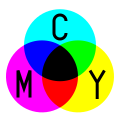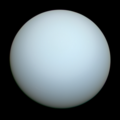Cyan
| Cyan | |
|---|---|
| Source | CSS Color Module Level 4000 |
| B: Normalized to [0–255] (byte) H: Normalized to [0–100] (hundred) | |
Cyan (/ˈsaɪ.ən, -æn/)[1][2][3] is the color between blue and green on the visible spectrum of light.[4][5] It is evoked by light with a predominant wavelength between 490 and 520 nm, between the wavelengths of green and blue.[6]
In the
Shades and variations of cyan
Different shades of cyan can vary in terms of hue, chroma (also known as saturation, intensity, or colorfulness), or lightness (or value, tone, or brightness), or any combination of these characteristics. Differences in value can also be referred to as tints and shades, with a tint being a cyan mixed with white, and a shade being mixed with black.
Color nomenclature is subjective. Many shades of cyan with a bluish hue are called blue. Similarly, those with a greenish hue are referred to as green. A cyan with a dark shade is commonly known as teal. A teal blue shade leans toward the blue end of the spectrum. Variations of teal with a greener tint are commonly referred to as teal green.[7]
Turquoise, reminiscent of the stone with the same name, is a shade in the green spectrum of cyan hues.[8] Celeste is a lightly tinted cyan that represents the color a clear sky. Other colors in the cyan color range are electric blue, aquamarine, and others described as blue-green.
History of cyan
Cyan boasts a rich and diverse history, holding cultural significance for millennia. In ancient civilizations, turquoise, valued for its aesthetic appeal, served as a highly regarded precious gem. Turquoise comes in a variety of shades from green to blue, but cyan hues are particularly prevalent. Approximately 3,700 years ago, an intricately crafted dragon-shaped treasure made from over 2,000 pieces of turquoise and jade was created. This artifact is widely recognized as the oldest Chinese dragon totem by many Chinese scholars.[9]
Turquoise jewelry also held significant importance among the Aztecs, who often featured this precious gemstone in vibrant frescoes for both symbolic and decorative purposes. The Aztecs revered turquoise, associating its color with the heavens and sacredness.[10] Additionally, ancient Egyptians interpreted cyan hues as representing faith and truth, while Tibetans viewed them as a symbol of infinity.[11]
After earlier uses in various contexts, cyan hues found increased use in diverse cultures due to their appealing aesthetic qualities in religious structures and art pieces. For example, the prominent dome of the Goharshad Mosque in Iran, built in 1418, showcases this trend. Additionally, Jacopo da Pontormo's use of a teal shade for Mary's robe in the 1528 painting Carmignano Visitation demonstrates the allure for these hues.[12] During the 16th century, speakers of the English language began using the term turquoise to describe the cyan color of objects that resembled the color of the stone.[13]
In the 1870s, the French sculptor
Impressionist artists, such as
In the late 19th century, while traditional nomenclature of red, yellow, and blue persisted, the printing industry initiated a shift towards utilizing magenta and cyan inks for red and blue hues, respectively. This transition aimed to establish a more versatile color
In August 1991, the HP Deskwriter 500C became the first Deskwriter to offer color printing as an option. It used interchangeable black and color (cyan, magenta, and yellow) inkjet print cartridges.[18] With the inclusion of cyan ink in printers, the term "cyan" has become widely recognized in both home and office settings. According to TUP/Technology User Profile 2020, approximately 70% of online American adults regularly use a home printer.[19]
Etymology and terminology
Its name is derived from the
In most languages, 'cyan' is not a basic color term and it phenomenologically appears as a greenish vibrant hue of blue to most English speakers. Other English terms for this "borderline" hue region include blue green, aqua, turquoise,[27] teal, and grue.[28]
Cyan on the web and printing
The web colors cyan and aqua
| Cyan (additive secondary) | |
|---|---|
X11 | |
| ISCC–NBS descriptor | Brilliant bluish green |
| B: Normalized to [0–255] (byte) | |
The
The web colors are more vivid than the cyan used in the
Process cyan
| Cyan (subtractive primary) | ||
|---|---|---|
| (69, 74, 229°) | ||
| Source | CMYK[30][unreliable source?] | |
| ISCC–NBS descriptor | Brilliant greenish blue | |
| B: Normalized to [0–255] (byte) | ||
Cyan is also one of the common inks used in
; this set of colors is referred to as CMYK. In printing, the cyan ink is sometimes known as printer's cyan, process cyan, or process blue.While both the additive secondary and the subtractive primary are called cyan, they can be substantially different from one another. Cyan printing ink is typically more saturated than the RGB secondary cyan, depending on what
In science and nature
Color of water
- Pure water is nearly colorless. However, it does absorb slightly more red light than blue, giving significant volumes of water a bluish tint; increased scattering of blue light due to fine particles in the water shifts the blue color toward green, for a typically cyan net color.[32]
Cyan and cyanide
- Cyanide derives its name from Prussian blue, a blue pigment containing the cyanide ion.[33]
Bacteria
- Cyanobacteria (sometimes called blue-green algae) are an important link in the food chain.[34]
Astronomy
- The planet Uranus is colored cyan because of the abundance of methane in its atmosphere. Methane absorbs red light and reflects the blue-green light which allows observers to see it as cyan.[35]
Energy
Photography and film
- Cyanotype, or blueprint, a monochrome photographic printing process that predates the use of the word cyan as a color, yields a deep cyan-blue colored print based on the Prussian blue pigment.[37]
- Cinecolor, a bi-pack color process, the photographer would load a standard camera with two films, one orthochromatic, dyed red, and a panchromatic strip behind it. Color light would expose the cyan record on the ortho stock, which also acted as a filter, exposing only red light to the panchromatic film stock.[38][39]
Medicine
- Cyanosis is an abnormal blueness of the skin, usually a sign of poor oxygen intake; patients are typically described as being "cyanotic".[40]
- Cyanopsia is a color vision defect where vision is tinted blue. This can be a drug-induced side effect or experienced after cataract removal.
Gallery
-
In the RGB color model, used to make colors on computer and TV displays, cyan is created by the combination of green and blue light.
-
In the RGB color wheel of subtractive colors, cyan is midway between blue and green.
-
In the CMYK color model, used in color printing, cyan, magenta and yellow combined make grey. In practice, since the inks are not perfect, some black ink is added.
-
Color printers today use, magenta, cyan and yellow ink to produce a wide range of colors.
-
Cyan and red are contrasting colors. They have strong contrast and harmony, and if combined, they make grey.
-
Cyan is the color of shallow water over a sandy beach. The water absorbs the color red from the sunlight, leaving a greenish-blue color.
-
The dome of the Tilla Kari Mosque in Samarkand, Uzbekistan (1660) is cyan. The color is widely used in architecture in Turkey and Central Asia.
-
The planetmethane gasand atmospheric haze in the planet's atmosphere.
-
A surgical team in Germany. It has been suggested that surgeons and nurses adopted a cyan-colored gown and operating rooms because it contrasts the color of red blood, thus reducing glare,[41] though the evidence for this claim is limited.
-
The pigments in color photographs may degrade at different rates, potentially resulting in a cyan tint.
See also
References
- ^ "cyan". Oxford English Dictionary (Online ed.). Oxford University Press. (Subscription or participating institution membership required.)
- ^ "cyan". Dictionary.com Unabridged (Online). n.d. Retrieved 30 September 2014.
- ^ "cyan". The American Heritage Dictionary of the English Language (5th ed.). HarperCollins.
- ^ "cyan". Merriam-Webster.com Dictionary. Retrieved 30 September 2014.
- ^ Shorter Oxford English Dictionary (5th ed.). Oxford University Press. 2002.
- About.com. Archived from the originalon 3 January 2012. Retrieved 30 September 2014.
- ^ Sadana, Nishtha (11 August 2021). "What Color Is Teal? How You Can Use it in Your Home". Knock Off Decor. Retrieved 2024-02-13.
- ^ "What is the difference between cyan and turquoise?". Difference Digest. 2023-08-20. Retrieved 2024-02-13.
- ^ "Archaeologists Find Oldest Chinese Dragon Totem". Xinhua News Agency. 2005-11-01. Retrieved 2024-02-14.
- ^ "What are the Aztec colors?". AZTECZONE. 2023-08-12. Retrieved 2024-02-14.
- ^ Parker, Dian (2022-06-21). "The Allure and Power of the Color Teal". Art & Object. Retrieved 2024-02-21.
- ^ Parker, Dian (2022-06-21). "The Allure and Power of the Color Teal". Art & Object. Retrieved 2024-02-21.
- ^ Maerz and Paul (1930). A Dictionary of Color. New York: McGraw-Hill. p. 206; Color Sample of Turquoise [green]: Page 73, Plate 25, Color Sample I5.
- ^ Parker, Dian (2022-06-21). "The Allure and Power of the Color Teal". Art & Object. Retrieved 2024-02-21.
- ^ Grant, Kim; Cramer, Charles (2021). "Impressionist color". Khan Academy. Google Classroom. Retrieved 2024-02-21.
- ^ Maerz and Paul (1930). A Dictionary of Color. New York: McGraw-Hill. pp. 205 (text), 101 (teal color sample). Plate 39 color sample L7 (on p. 101)
- ^ Wright, Laura (2011-11-27). "Semantic shift of the colour-terms maroon and magenta in British Standard English". Revista de Lenguas para Fines Específicos. 17: 341–376.
- ^ "Twenty Years of Innovation: HP Deskjet Printers 1988 – 2008" (PDF). Hewlett-Packard. 2008.
- ^ Ness, Dan (2021-02-25), Home Printer Trends in the US, retrieved 2024-04-21
- ^ "Online Etymology Dictionary". Retrieved 30 September 2014.
- ^ "Henry George Liddell, Robert Scott, A Greek-English Lexicon, κύα^νος". Retrieved 30 September 2014.
- ^ J. Arthur H. Hatt (1908). The Colorist: Designed to Correct the Commonly Held Theory that Red, Yellow, and Blue are the Primary Colors and to Supply the Much Needed Easy Method of Determining Color Harmony. D. Van Nostrand Company. p. 22.
- ^ Shorter Oxford English Dictionary, 5th edition.
- ^ Maerz and Paul A Dictionary of Color New York:1930 McGraw-Hill page 194
- ISBN 9781136373855
- ISBN 9781136373855. Retrieved 30 September 2014.
- ISBN 9780199915101. Retrieved 31 July 2019.
- ^ Kay, Paul; Maffi, Luisa. "Number of Basic Colour Categories". The World Atlas of Language Structures Online. Max Planck Institute for Evolutionary Anthropology. Retrieved 4 May 2021.
- ^ Maerz and Paul The Dictionary of Color 1930 (see under Aqua in Index, page 189)
- ^ "tintbook.com". Archived from the original on 10 March 2007. Retrieved 30 September 2014.
- ISBN 9780123918895. Retrieved 31 July 2019.
- ISBN 0-486-41738-7.
- ISBN 9780081018897.
- ISBN 9781466695603.
- ^ "Uranus in True and False Color". NASA. 2015-04-02. Retrieved 2017-09-28.
- ^ Hahn, Eric. "Gas Flame Colour Temperature Chart (Yellow Flame vs Blue Flame)". ELGAS – LPG Gas for Home & Business. Retrieved 2017-11-10.
- ISBN 1-900747-07-3.
- ^ Belton, John (2000): CinecoIor. In: Film History, 12,4, Color Film (2000), pp. 344–357.
- ^ "Cinecolor". widescreenmuseum.com. Retrieved 2017-11-10.
- Mosby's Medical, Nursing & Allied Health Dictionary. Mosby-Year Book (4th ed.). 1994. p. 425.
- PMID 10026627.












